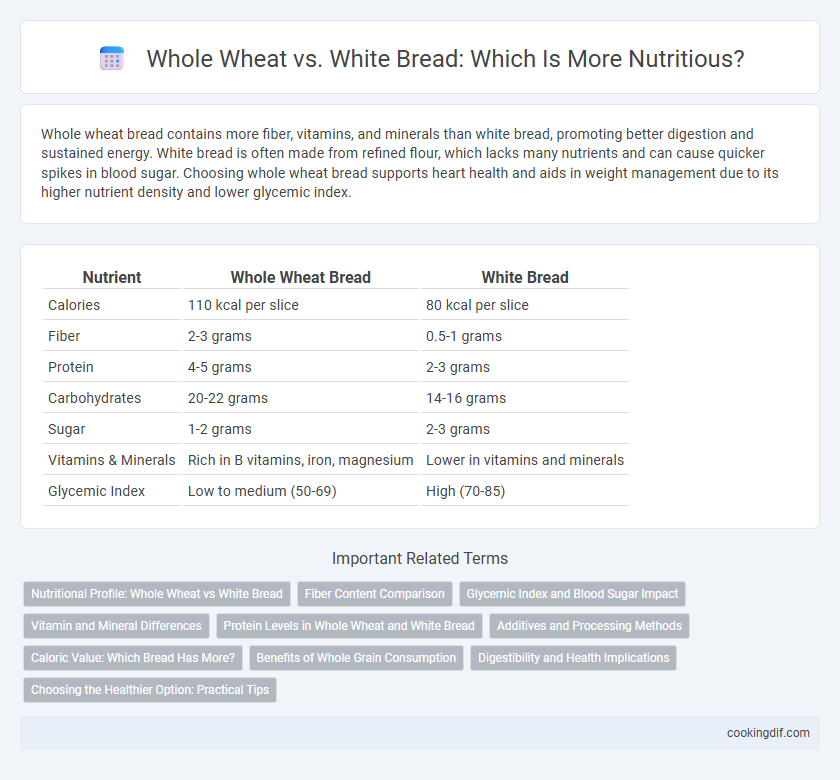Whole wheat bread contains more fiber, vitamins, and minerals than white bread, promoting better digestion and sustained energy. White bread is often made from refined flour, which lacks many nutrients and can cause quicker spikes in blood sugar. Choosing whole wheat bread supports heart health and aids in weight management due to its higher nutrient density and lower glycemic index.
Table of Comparison
| Nutrient | Whole Wheat Bread | White Bread |
|---|---|---|
| Calories | 110 kcal per slice | 80 kcal per slice |
| Fiber | 2-3 grams | 0.5-1 grams |
| Protein | 4-5 grams | 2-3 grams |
| Carbohydrates | 20-22 grams | 14-16 grams |
| Sugar | 1-2 grams | 2-3 grams |
| Vitamins & Minerals | Rich in B vitamins, iron, magnesium | Lower in vitamins and minerals |
| Glycemic Index | Low to medium (50-69) | High (70-85) |
Nutritional Profile: Whole Wheat vs White Bread
Whole wheat bread contains higher fiber content, essential vitamins like B-complex, and minerals such as iron and magnesium compared to white bread, which is often made from refined flour with fewer nutrients. The glycemic index of whole wheat bread is lower, promoting better blood sugar control and sustained energy release. Whole wheat bread also offers more antioxidants and protein, contributing to improved digestive health and muscle maintenance.
Fiber Content Comparison
Whole wheat bread contains approximately 2 to 3 grams of fiber per slice, significantly higher than white bread, which typically has less than 1 gram. The increased fiber in whole wheat bread aids in digestive health, supports blood sugar regulation, and promotes satiety. Choosing whole wheat bread enhances daily fiber intake, contributing to better overall nutrition and reduced risk of chronic diseases.
Glycemic Index and Blood Sugar Impact
Whole wheat bread has a lower glycemic index (GI) compared to white bread, typically ranging from 50 to 65 versus white bread's GI of 70 to 85, which results in a slower and more gradual increase in blood sugar levels. The higher fiber content in whole wheat bread helps improve insulin sensitivity and aids in better blood sugar management, making it a preferable choice for individuals with diabetes or insulin resistance. White bread, made from refined flour, causes quicker blood sugar spikes and may contribute to increased risk of type 2 diabetes and weight gain when consumed frequently.
Vitamin and Mineral Differences
Whole wheat bread contains higher levels of essential vitamins and minerals such as vitamin E, B vitamins including folate, iron, magnesium, and zinc compared to white bread, which is typically lower due to the refining process. The bran and germ present in whole wheat contribute to its richer nutrient profile, whereas white bread often lacks many micronutrients despite sometimes being fortified. Choosing whole wheat bread supports better intake of antioxidants and minerals crucial for metabolism and immune function.
Protein Levels in Whole Wheat and White Bread
Whole wheat bread contains approximately 4 grams of protein per slice, compared to white bread, which provides around 2 to 3 grams per slice, making whole wheat a superior choice for higher protein intake. The increased protein content in whole wheat bread contributes to better muscle maintenance and satiety, supporting overall nutrition goals. Whole wheat bread also retains the grain's bran and germ, offering additional nutrients that white bread lacks due to its refined flour.
Additives and Processing Methods
Whole wheat bread contains minimal additives and undergoes less processing, preserving essential nutrients like fiber, vitamins, and minerals. White bread is heavily processed, with bran and germ removed, often resulting in added sugars, preservatives, and artificial additives to improve texture and shelf life. The difference in processing methods significantly impacts the nutritional quality, making whole wheat bread a healthier option with fewer synthetic ingredients.
Caloric Value: Which Bread Has More?
Whole wheat bread generally contains slightly fewer calories than white bread, with approximately 110 to 120 calories per slice compared to 120 to 130 calories in white bread. The higher fiber content in whole wheat bread contributes to increased satiety and slower digestion, impacting its caloric absorption. Nutritionally, whole wheat bread offers more vitamins, minerals, and antioxidants, making it a healthier choice despite the close caloric values.
Benefits of Whole Grain Consumption
Whole wheat bread contains higher levels of dietary fiber, vitamins, and minerals compared to white bread, which is made from refined flour stripped of bran and germ. Consuming whole grain products like whole wheat supports improved digestion, better blood sugar control, and a reduced risk of cardiovascular diseases. Nutrient-dense whole grains also provide antioxidants and phytochemicals that contribute to long-term health benefits.
Digestibility and Health Implications
Whole wheat bread contains higher fiber content than white bread, promoting better digestion and sustained blood sugar levels. The bran and germ in whole wheat provide essential nutrients and antioxidants that support heart health and reduce inflammation. White bread undergoes refining that removes these components, resulting in lower nutrient density and faster digestion, which may contribute to blood sugar spikes and reduced satiety.
Choosing the Healthier Option: Practical Tips
Whole wheat bread contains higher fiber content, essential vitamins like B-complex, and minerals such as iron and magnesium compared to white bread, which is often made from refined flour with fewer nutrients. Opt for whole wheat bread to support better digestion, stable blood sugar levels, and improved heart health. When selecting bread, check labels for 100% whole grain content, minimal added sugars, and avoid artificial preservatives to ensure maximum nutritional benefits.
Whole Wheat vs White Bread for nutrition Infographic

 cookingdif.com
cookingdif.com